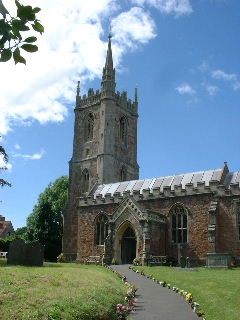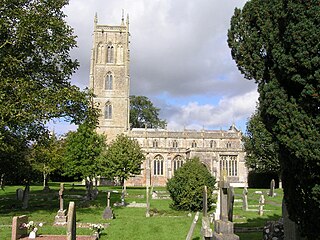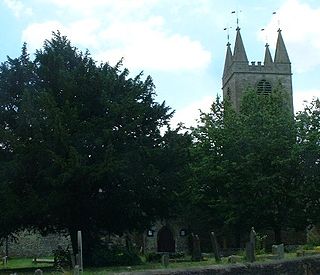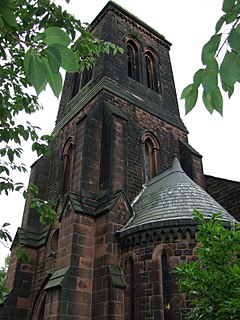
Winscombe is a large village in the North Somerset unitary district of Somerset, South West England, close to the settlements of Axbridge and Cheddar, on the western edge of the Mendip Hills, 7 miles (11 km) southeast of Weston-super-Mare and 14 miles (23 km) southwest of Bristol. The Parish of Winscombe and Sandford, centred on the Parish Church of Church of St James the Great, includes the villages/hamlets of Barton, Hale, Oakridge, Nye, Sidcot and Woodborough.

St Andrew's Church is a Church of England parish church located in the village of Mells in the English county of Somerset. The church is a grade I listed building.

The Anglican St Andrew's Church is on the outskirts of Chew Stoke, within the English county of Somerset. The church, parts of which date from the 15th century, is a Grade II* listed building.

The Church of St Mary the Virgin is in Leek Road, Bosley, Cheshire, England. It is recorded in the National Heritage List for England as a designated Grade II* listed building. It is an active Anglican parish church in the diocese of Chester, the archdeaconry of Macclesfield, and the deanery of Macclesfield. Its benefice is combined with those of St Michael, North Rode, St Michael, Wincle, and St Saviour, Wildboarclough.

The Church of St Mary Magdalene in Chewton Mendip, Somerset, England, was built in the 1540s and has been designated as a Grade I listed building. It is dedicated to Jesus' companion Mary Magdalene.

The Church of St Peter in Huish Champflower, Somerset, England dates from the 15th century, with the north aisle being built in 1534. It has been designated by English Heritage as a Grade I listed building.

The Church of St Andrew in Cheddar, Somerset, England dates from the 14th century and has been designated as a Grade I listed building.

The Church of All Saints which is next to the River Brue in Alford, Somerset, England dates from the 15th century, with minor 19th-century restoration. It has been designated as a Grade I listed building.

The Church of St John the Baptist in Yeovil, Somerset, is a Church of England Parish Church.

Holy Trinity Church, Morecambe, or Morecambe Parish Church, is in Church Street, Morecambe, Lancashire, England. It is the Anglican parish church of Morecambe, in the deanery of Lancaster, the archdeaconry of Lancaster and the diocese of Blackburn. The church is recorded in the National Heritage List for England as a designated Grade II listed building.

The Church of St Peter in Marksbury, Somerset, England dates from the 12th century, although most of the current fabric is from the 15th century and is a Grade II* listed building.

St Michael's Church is in the village of Bootle, Cumbria, England. It is an active Anglican parish church in the deanery of Calder, the archdeaconry of West Cumberland, and the diocese of Carlisle. Its benefice has been united with those of St John the Baptist, Corney, St Mary, Whicham, and St Mary, Whitbeck. The church is recorded in the National Heritage List for England as a designated Grade II listed building.

St Chad's Church is on Chester Road in the civil parish of Tushingham-cum-Grindley, Macefen and Bradley, Cheshire, England. It is an active Anglican parish church in the deanery of Malpas, the archdeaconry of Chester, and the diocese of Chester. Its benefice is combined with those of St Michael, Marbury, and St Mary, Whitewell. The church is recorded in the National Heritage List for England as a designated Grade II listed building.

St James' Church stands in an elevated position in the village of Cardington, Shropshire, England. It is an active Anglican parish church in the deanery of Condover, the archdeaconry of Ludlow, and the diocese of Hereford. The church is recorded in the National Heritage List for England as a designated Grade I listed building.

St James' Church is in Mill Lane, West Derby, a suburb of Liverpool, Merseyside, England. It was an active Anglican parish church in the deanery of West Derby, the archdeaconry of Liverpool, and the diocese of Liverpool until 23 June 2019 when responsibility was handed over to the Indian Orthodox Church. Its benefice is united with that of St Mary, West Derby. The church is designated by English Heritage as a Grade II listed building.

St James' Church is in St James' Road, Church, Hyndburn, Lancashire, England. It was an active Anglican parish church in the deanery of Accrington, the archdeaconry of Blackburn, and the diocese of Blackburn until November 2015 when it was closed. The church is recorded in the National Heritage List for England as a designated Grade II* listed building.

The Anglican Parish Church of St Nicholas and the Blessed Virgin Mary at Stowey within the English county of Somerset dates from the 13th century. It is a Grade II listed building.

St John the Evangelist's Church is in Church Lane, Yealand Conyers, Lancashire, England. It is an active Anglican parish church in the diocese of Blackburn. The church was built in 1838, extended in 1861 and again in 1882. It is constructed mainly in limestone, and consists of a nave, a north aisle, a chancel and a west tower. Inside is a west gallery and stained glass by Shrigley and Hunt. The church holds services on Sundays and Wednesdays. It is recorded in the National Heritage List for England as a designated Grade II listed building.

St Paul's Church stands off Berry Lane, Longridge, Lancashire, England. It is an active Anglican parish church in the diocese of Blackburn. The church was built in 1886–1888, and the tower was added in 1936–37. The church is recorded in the National Heritage List for England as a designated Grade II listed building.

All Saints Church is a Church of England church in Sandford, Somerset, England. Designed by Hans Price and William Wooler, it was built in 1883–84 and has been a Grade II listed building since 1983. Today the church is in a local ecumenical partnership with Sandford Methodist Church.




















